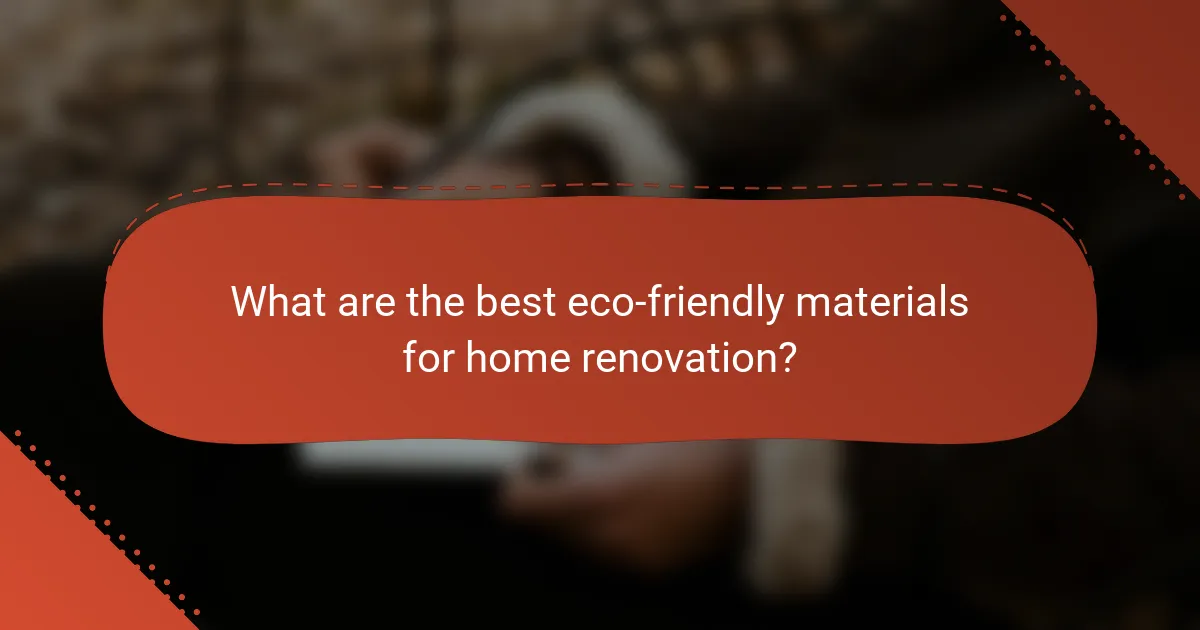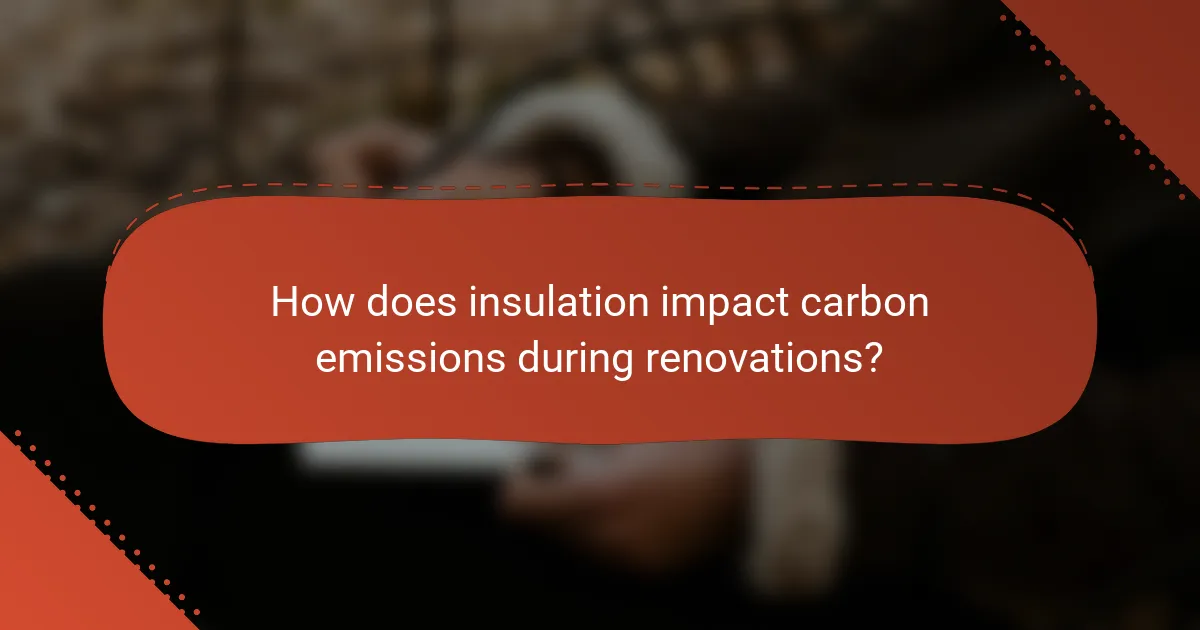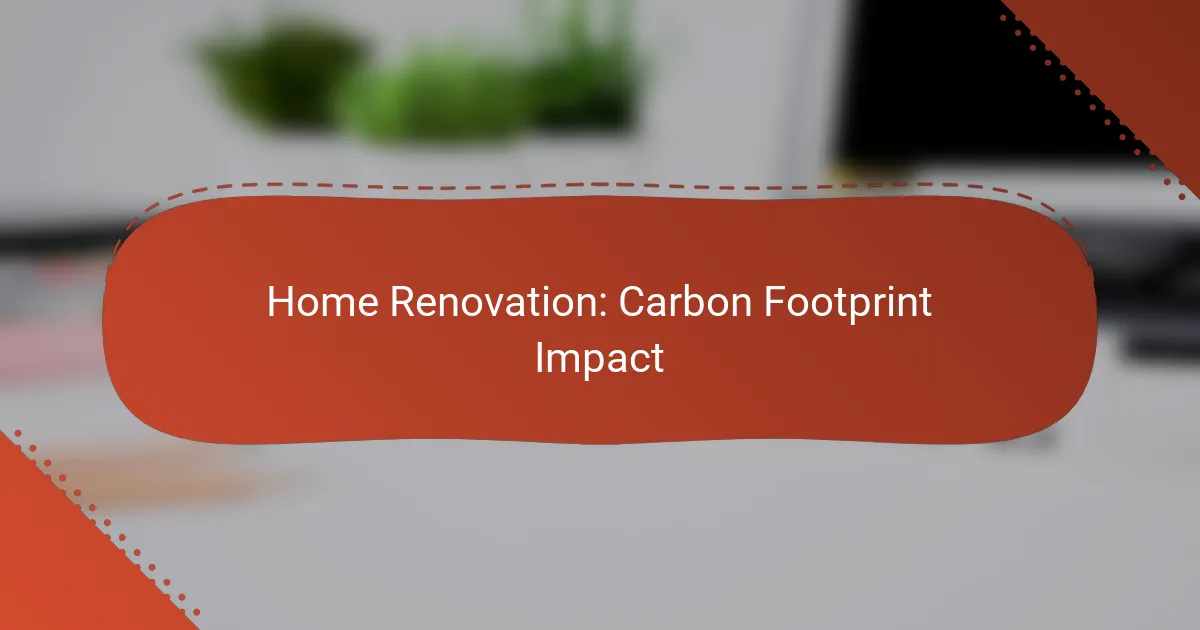Home renovation presents a unique opportunity to minimize carbon footprints through the adoption of energy-efficient practices and sustainable materials. By prioritizing eco-friendly upgrades, homeowners can significantly reduce energy consumption and greenhouse gas emissions, all while enhancing the comfort and value of their living spaces.

How can home renovation reduce carbon footprint in the US?
Home renovation can significantly reduce carbon footprints in the US by incorporating energy-efficient practices and materials. By focusing on sustainable upgrades, homeowners can lower energy consumption and greenhouse gas emissions while enhancing comfort and value.
Energy-efficient materials
Using energy-efficient materials is crucial for minimizing carbon footprints during renovations. Insulation, windows, and doors that meet or exceed Energy Star standards can drastically reduce heating and cooling needs.
Consider materials like recycled steel, bamboo flooring, or low-VOC paints, which not only lower emissions but also improve indoor air quality. Investing in these materials may have higher upfront costs but can lead to substantial savings on energy bills over time.
Smart home technology
Smart home technology helps optimize energy use, contributing to a reduced carbon footprint. Devices like smart thermostats, energy monitors, and automated lighting systems allow homeowners to manage energy consumption more effectively.
For example, a smart thermostat can adjust heating and cooling based on occupancy patterns, potentially reducing energy use by 10-15%. When integrating smart technology, ensure compatibility with existing systems for seamless operation.
Renewable energy integration
Integrating renewable energy sources, such as solar panels, can significantly cut down a home’s carbon emissions. Solar energy systems can provide a substantial portion of a household’s electricity needs, especially in sunny regions of the US.
Homeowners should evaluate local incentives and rebates for solar installations, which can offset initial costs. Additionally, consider battery storage systems to maximize the use of generated solar energy, further enhancing sustainability.

What are the best eco-friendly materials for home renovation?
The best eco-friendly materials for home renovation include recycled materials, sustainable wood options, and low-VOC paints. These choices not only reduce environmental impact but also enhance indoor air quality and promote sustainability in construction.
Recycled materials
Recycled materials are an excellent choice for eco-friendly renovations, as they repurpose existing resources, reducing waste. Common options include reclaimed wood, recycled metal, and glass tiles. Using these materials can significantly lower the carbon footprint of your renovation project.
When selecting recycled materials, check for certifications that ensure quality and environmental compliance. For example, look for products that meet standards like the Forest Stewardship Council (FSC) for wood or the Recycling Industry Operating Standard (RIOS) for metals.
Sustainable wood options
Sustainable wood options, such as bamboo or FSC-certified lumber, are harvested in ways that maintain ecological balance. Bamboo grows rapidly and can be harvested without killing the plant, making it a highly renewable resource. In contrast, FSC-certified wood comes from forests that are managed responsibly, ensuring minimal environmental impact.
When choosing sustainable wood, consider the specific application and durability requirements. For flooring, look for hardwoods that are locally sourced to reduce transportation emissions. Always verify the sustainability certifications to ensure the wood meets environmental standards.
Low-VOC paints
Low-VOC (volatile organic compounds) paints are formulated to minimize harmful emissions, making them a healthier choice for indoor environments. These paints help improve air quality and reduce the risk of respiratory issues associated with traditional paints. Many brands now offer a wide range of colors and finishes without compromising performance.
When selecting low-VOC paints, check for labels that indicate VOC levels and look for certifications like Green Seal or the EPA’s Safer Choice. It’s advisable to ventilate the area during and after application to further enhance air quality.

How does insulation impact carbon emissions during renovations?
Insulation significantly reduces carbon emissions during home renovations by improving energy efficiency. Proper insulation minimizes the need for heating and cooling, which in turn lowers greenhouse gas emissions associated with energy consumption.
Types of insulation
There are several types of insulation, each with different properties and environmental impacts. Common options include fiberglass, foam board, spray foam, and cellulose. Fiberglass is often favored for its cost-effectiveness, while cellulose is made from recycled materials, making it a more sustainable choice.
When selecting insulation, consider factors such as thermal performance, moisture resistance, and fire safety. Each type has its advantages and disadvantages, so it’s essential to evaluate them based on your specific renovation needs.
Insulation R-values
R-value measures insulation’s effectiveness in resisting heat flow; higher values indicate better performance. For residential applications, R-values typically range from R-13 for walls to R-60 for attics, depending on climate and building codes. Understanding the required R-value for your area can help you choose the right insulation material.
In colder climates, higher R-values are crucial to minimize heat loss, while milder regions may require less insulation. Always check local building regulations to ensure compliance with insulation standards.
Installation techniques
Proper installation of insulation is critical for maximizing its effectiveness and minimizing carbon emissions. Techniques vary by insulation type; for example, fiberglass batts should be fitted snugly without gaps, while spray foam requires professional application for optimal results.
Common pitfalls include compressing insulation, which reduces its R-value, and leaving gaps that allow air leakage. To avoid these issues, follow manufacturer guidelines and consider hiring a professional for complex installations.

What are the costs associated with eco-friendly renovations?
Eco-friendly renovations often involve higher upfront costs but can lead to significant long-term savings. Understanding these costs is essential for homeowners looking to balance environmental impact with budget considerations.
Initial investment vs. long-term savings
The initial investment for eco-friendly renovations can be substantial, often ranging from 10% to 30% more than traditional options. However, these renovations typically result in lower utility bills and maintenance costs over time, leading to savings that can offset the initial expenditure.
For example, energy-efficient windows may cost more upfront but can reduce heating and cooling costs significantly, sometimes saving hundreds of dollars annually. Homeowners should calculate the payback period to understand when the savings will surpass the initial investment.
Cost of sustainable materials
Sustainable materials, such as bamboo flooring or recycled glass countertops, can be pricier than conventional materials. Prices can vary widely, with eco-friendly options often falling in the mid to high range of typical renovation costs.
When selecting sustainable materials, consider their durability and lifecycle costs. Investing in higher-quality materials may reduce the need for replacements and repairs, ultimately saving money in the long run.
Government incentives
Many governments offer incentives for eco-friendly renovations, which can help offset costs. These incentives may include tax credits, rebates, or grants, depending on the region and specific projects undertaken.
Homeowners should research available programs, as they can vary significantly by location. For instance, in the U.S., the Energy Star program provides tax credits for energy-efficient upgrades, while some European countries offer grants for sustainable building practices. Taking advantage of these incentives can make eco-friendly renovations more financially feasible.

How can homeowners measure their renovation’s carbon footprint?
Homeowners can measure their renovation’s carbon footprint by using various tools and methodologies designed to quantify greenhouse gas emissions associated with construction activities. These measurements help identify areas for improvement and guide decisions toward more sustainable practices.
Carbon footprint calculators
Carbon footprint calculators are online tools that allow homeowners to estimate the emissions generated by their renovation projects. Users typically input data such as materials used, energy consumption, and waste produced, which the calculator then processes to provide an estimated carbon footprint.
When choosing a calculator, consider its accuracy and the specific factors it includes. Some calculators may focus more on energy use, while others might account for a broader range of materials and processes. Popular options include the Carbon Trust’s calculator and the EPA’s Household Carbon Footprint Calculator.
Life cycle assessment tools
Life cycle assessment (LCA) tools provide a comprehensive evaluation of the environmental impact of renovation materials and processes from production to disposal. These tools help homeowners understand the total carbon emissions associated with their choices over the entire life span of the materials.
Using LCA tools can be more complex than simple calculators, as they require detailed input about materials, energy sources, and usage patterns. However, they offer valuable insights for making informed decisions. Resources like the Athena Sustainable Materials Institute provide LCA tools tailored for building materials.

What are the local regulations for sustainable renovations in California?
California has strict regulations aimed at promoting sustainable renovations, focusing on energy efficiency, water conservation, and the use of environmentally friendly materials. Homeowners must comply with the California Green Building Standards Code, also known as CALGreen, which sets minimum requirements for sustainable building practices.
Building codes
Building codes in California require that all renovations meet specific energy efficiency standards. These codes cover aspects such as insulation, windows, and HVAC systems, ensuring that homes consume less energy and reduce their carbon footprint. For instance, new windows must meet certain U-factor and solar heat gain coefficient ratings.
Additionally, CALGreen mandates the use of sustainable materials and practices. This includes requirements for recycling construction waste and using low-emission products. Homeowners should familiarize themselves with local amendments to these codes, as municipalities may have additional regulations.
Before starting a renovation project, it is advisable to consult with a licensed contractor who understands local building codes. This can help avoid costly mistakes and ensure compliance with all regulations, ultimately leading to a more sustainable home renovation.
